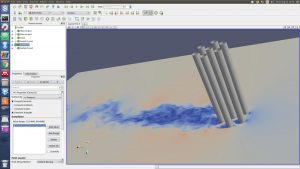Dr Jon Downes and Artur Lidkte attended the first general assembly of Bringing together Research and Industry for the Development of Glider Enviromental Services – BRIDGES, which took place in Porto, Portugal.

The Faculty of Engineering of the University of Porto, FEUP (http://lsts.pt/blog/bridges-1%C2%AA-general-assembly) – hosted the meeting on 6, 7 and 8 September 2016. This meeting aimed to evaluate the project status and share results and solutions between the different partners involved in the project.
BRIDGES is a consortium of 19 public and private partners from 7 European countries (SP, PT, UK, FR, NL, D, CY) and 2 from associated countries (NO, IS). The project is coordinated by ARMINES ENSTA-ParisTech

For more about the progress and news of BRIDGES please visit: www.bridges-h2020.eu
Gliding forwards
Dr Jon Downes was one of 150 delegates from across Europe that visited the NOC in Southampton for the 7th EGO conference on autonomous ocean gliders and their applications. The conference, hosted by the NOC, provided a forum in which scientists, engineers, students and industry exchanged knowledge and experiences on the development of glider technology, the application of gliders in oceanographic research and the role of gliders in ocean observing systems. Presentations included work from the EU H2020 Bridges Project developing the next generation gliders (http://www.bridges-h2020.eu/) that the University is contributing to.
Bridges visits the City of Bridges!
An EXCEL-lent summer
One of our summer placement student’s Aaron Page reports on his summer with FSI as part of the Maritime Robotics Lab. This was a paid internship the University of Southampton’s EXCEL scheme we will be advertising similar opportunities for next summer in the spring.
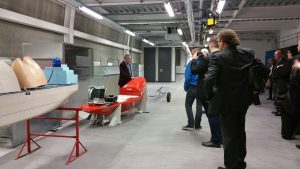
As a recently graduated electromechanical engineer from the University of Southampton, having the opportunity to spend two months at the highly regarded Bolderwood innovation campus with the FSI (Fluid Interactions Group) department was a fantastic opportunity to apply my studies to a real word engineering application. During my time I was working on a new control architecture for the Motors and Rudders on a previously student designed and built vessel called Fortitude this alongside further refitting will lead to long term deployments in the transatlantic and other areas for data gathering missions.
The project allowed me to apply my knowledge of control theory, whilst allowing me to further develop my skills as a programmer. I was given complete freedom to peruse the objective allowing me to approach it in the way I believed would yield the best results, this alongside regular weekly meetings with my supervisors ensured all options, and potential issues were highlighted and investigated. Various control methods were considered and how they could later be integrated with different autonomous control approaches and object avoidance algorithm’s, ensuring future steps in this multi-layered project are as smooth as possible. Being involved so early in this project has also given me the opportunity to identify problems that may be encountered later on in the projects life as well as make suggestions that may alter the direction of hardware selection.
Being invited to the weekly FSI seminar meetings where PhD students gave presentations on their research, furthered my knowledge of a field I had very little exposure to previously. This, alongside the summer events run by the staff and PhD students, has made my time with them very enjoyable.
This internship, run in partnership with the EXCEL scheme, has helped me developed a range of skills that I will now be applying as I start my PhD at the University of Southampton within ECS. I hope to remain involved with the project and look forward to seeing how it develops over the next couple of years.
The Route to Sustainable Shipping
A combined SMMI and FSI panel discussion
Wed 12th October 2016 at 18:00
University of Southampton, Boldrewood Campus, 1125/176L
FSI post grad student Josh Taylor has organised a panel discussion as part of Southampton Sustainability Week.
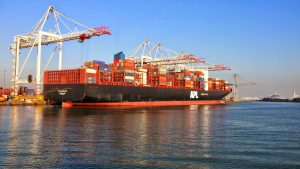
This public event explores the challenges faced by the maritime industry on the route to becoming more sustainable. The unique framework of the Southampton Marine and Maritime Institute facilitates the continued exchange of ideas between people in both academia and industry.
This event is part of Southampton’s first annual sustainability week and should provide a stimulating discussion to create opportunities for change while showcasing the maritime industry’s presence in Southampton. Southampton sustainability week is a series of city-wide events which encourage sustainable behaviour change by increasing awareness of issues and celebrating progress to date. The week is organised by a group of volunteers and headed by the founder Jenny Barnes.
A distinguished panel of industry experts and academics will discuss the challenges the maritime industry faces in achieving environmental sustainability, guided by structured questions from the chair, Professor Ajit Shenoi, University of Southampton director of the SMMI. The discussion topics will include Ship design, Maritime law, Regulation and innovation, Fleet operation, Waste management.
For those interested in attending please register for free via Eventbright:
https://www.eventbrite.co.uk/e/the-route-to-sustainable-shipping-tickets-28168759518
If you are interested in exploring our study opportunities in maritime engineering and ship science then the video interviews with two of our graduates Thomas and Emily from graduation this summer maybe useful.
Lets twist – how does it influence VIV?
This summer one of our recent MEng graduates Carlos Losada de la Lastra spent a month in Southampton and two in Singapore and reports on his research project in offshore hydrodynamics.
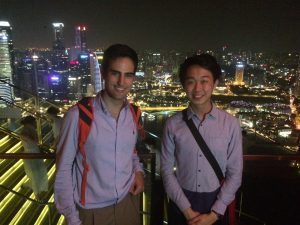
The offshore industry is tending towards multi-riser structures where the offshore platform or floating unit uses more than one pipe to meet more requirements. These pipes have a cylindrical cross section, which may induce vortex induced vibrations (VIV) as crossflow passes around them. This causes fatigue and high loading on the connection points at the seabed and the offshore structure.
The aim of the study was to investigate whether a helical arrangement of the cylinders could reduce the vibrations of the array and provide a wider operational window for offshore structures with multiple risers. I carried out the study using Assoc. Prof. Weymouth’s CFD solver, Lotus, to predict the flow around a seven cylinder array. The main parameters affecting the VIV of the array are, the flow speed, the gap between the cylinders, and the pitch of the array. Where the pitch governs the helicity of the array. To decouple each of the parameters I carried out separate investigations covering each of the parameters.
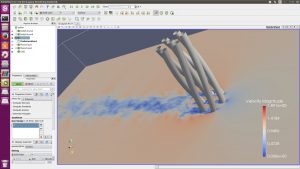
I started the parameter investigation by looking into the effects the gap had on the side force produced by the vortex shedding. I then started investigating the effects of varying the flow speed on the gap range of relevance. Before running simulations of the helical array I had to write a mapping function that twisted it. Having finished writing and validating the mapping function, I looked into the effects of varying the pitch of the array.
The project has been a really good experience. The idea of a helical array came from a question I asked during a lecture last January. This really motivated me throughout the project. The project itself provided a great insight to research. My two supervisors, Assoc Prof. Weymouth and Dr. Vinh Tan, provided invaluable guidance and help throughout the project, but it was up to me to run the simulations, deliver good results and contribute to the discussion. This allowed me both to develop and organise, my simulations, my thought process and my reasoning through the concepts. I learned a lot about hydrodynamics, running and automating simulations, and post processing of results. I also improved my programming and computing skills.
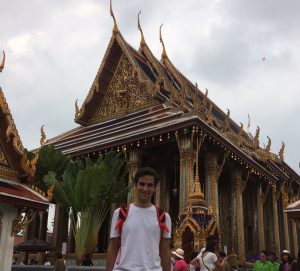
On the cultural side of things I managed to see and experience Singapore with many friends, and squeeze a trip to Bangkok on a weekend as a back packer.
UK Fluids Conference 2016
On the second week of September, the first Fluids UK Conference took place at the Imperial College in London. Several researchers across the UK and overseas gathered together to share their investigations in a very wide range of disciplines across fluid dynamics. A large number of researchers from the Aerodynamics and Flight Mechanics (AFM) and the Fluid-Structure Interactions (FSI) groups of the University of Southampton were also present in the event.
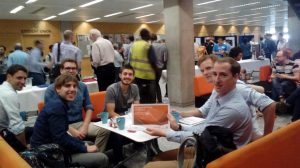
I am Bernat Font Garcia a first year PhD student and I recently attended my first conference as a speaker. I was part of a big group coming from the University of Southampton, one of the universities which brought more researchers into the event.
A total of 96 presentations were delivered during the three days of the conference. Presenters were either PhD students or post-docs, mostly. Each presenter had 10 minutes to explain the topic and 2 minutes were scheduled for questions. It was a challenging exercise to condense one year of work into such a short amount of time, although I can image this was even more difficult for students in the last year of the doctorate or post-docs researchers!
The topic of my presentation was: “A two-dimensional model for three-dimensional symmetric flows”. Using the well-known backward-facing step test case, the aim is to obtain the steady solution of the three-dimensional case at the symmetry plane using a two-dimensional model. Hence, instead of carrying a three-dimensional simulation, the solution is achieved by the two-dimensional Navier-Stokes equations plus additional terms. The main outcome of this work is the notable reduction of the computational time required to achieve the three-dimensional solution for symmetric or spatially-periodic flows.

Overall, it was very inspiring to get to know what topics are currently being investigated in fluid dynamics and to meet people working within this field. Also, it was the perfect opportunity to communicate my work and conclude the first year of my doctorate.
Trip to the Cape – passive adaptive foils for high performance yachts
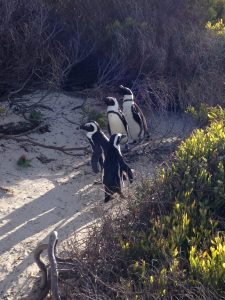
Recently Laura Marimon Giovannetti, a final year PhD student in FSI currently completing a 10 month placement at Ben Ainslie Racing attended the Sixth International Conference on Structural Engineering, Mechanics and Computation (SEMC 2016) in Cape Town, South Africa and reports below. We offer our congratulations to her on winning the best paper in the young researchers award category. She reports on some of the key parts of the conference.
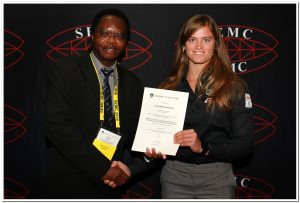
The conference featured 360 papers with authors representing 60 countries from all five continents. With a great number of fields of structural mechanics and a large number of papers, the competition for the best paper in the Young Researchers Award (under 35) was hard, but I managed to bring the award home. I was presented to the opening ceremony as the winner of the prize and I had the possibility to present my research in the largest room! I was very pleased with the compliment received for my paper by the conference organizer Prof. A. Zingoni of the University of Cape Town. Following my presentation I had some interesting questions and all the people in the room were pleased with my work on passive adaptive composite foil design based on coupled FSI using StarCCM+ and based on our validation studies in the R.J.Mitchell wind tunnel using synchronised PIV and DIC.
The topics of the conference were very broad, from fluid-structure interaction to soil-structures interaction (for earthquake damage-prevention) to composites and sandwich materials. Within the three days of the conference we had six parallel sessions running all day.

Keynote speakers were Prof. Kim Rasmussen (University of Sydney, Australia), Prof. Adnan Ibrahimbegovic (Universite Technologie Compiegne, France), Prof. Klaus-Jürgen Bathe (MIT, USA), Prof. Amr Elnashai (Pennsylvania State University, USA), Prof. Jian-Fei Chen (Queen’s University of Belfast, UK) and Prof. Guido De Roeck (KU Leuven, Belgium). All the keynotes were focusing on different aspects of structural mechanics and the ones that I liked the most were the one from Prof. Jian-Fei Chen and the one from Prof. Amr Elnashai.
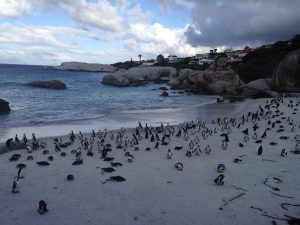
I have also met a large number of new people (from fellow PhD students to professors) and I had the opportunity to go with some new friends (PhD students at Ferrari) to visit Cape of Good Hope and the African penguins in Simon’s town.
I’d like to thank both the University of Southampton and Land Rover Ben Ainslie Racing for allowing me to attend this extremely interesting conference. I also would like to encourage people to travel to Cape Town, the city and its surroundings are beautiful and you can learn a lot about the history of the country visiting the Apartheid prison in Robben Island, where Mandela was held prisoner for 17 years.
First in class robot sailors
Over the last 9 months we designed, programmed and built a 1m long autonomous sailing robot, to compete in the four challenges of the World Robotic Sailing Championship in Portugal.
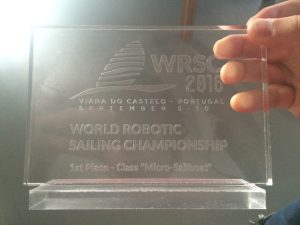
Our trip to Viana do Castello was a full success – not only did we learn a lot about sailing robots, but with a second place in both the position keeping and the area scanning and a first place in the obstacle avoidance, our overall position in the micro sailboat class is 1st place!
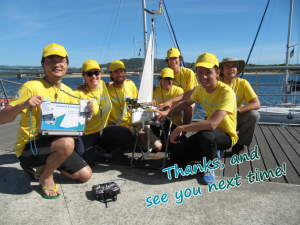
Many thanks to everyone who supported us, especially by joining our crowd funding campaign: Thanks Alistair Lynn, Tim Miller, Tobias Schnieder, Harry Cutts, Gan Soon Sun, Matt Brown, Fiona Collins, Arnaud Wiertz, Kerrine Lee, Andy Sprot, Bob Preston, Alex Ziang, Lee Yong, Duncan Ross Russel, Alessandro Romano and Simone Provenzano.
We are also very grateful to the University of Southampton, with the funding of the EEF we were able to focus on building our boat, and bring all the spare parts that kept our boat going.
Finally, our thanks go to the organisers of the competition, for making this adventure possible!
A more detailed description of our adventure can be found in our blog, as well as all our software and details of our boat build.
Now with many new ideas we are starting our preparations for the next competition – if you want to join us:
We meet every Thursday 6 pm, new members are welcome to join us from the beginning of the new term! Check our blog, facebook page, or twitter account for the location and dates of our introduction meetings.
Blog: https://sailrobot.wordpress.com/
Facebook: http://www.facebook.com/maritimeroboticssouthampton/
Twitter: https://twitter.com/sotonsailrobot
Government VIPs visit Maritime Robotics Lab

Recently, the Maritime Robotics Laboratory of the Fluid Structure Interactions Group hosted visitors from the Council for Science and Technology, Cabinet Office Analysis and Insight Team and from the Government Office for Science. They were given an overview of the development of maritime autonomous and robotic systems, developments in sensor technologies, and future directions of research in the field. The visit was supported by Dr Jon Downes, Dr Nick Townsend, Dr Blair Thornton and Prof Ajit Shenoi.
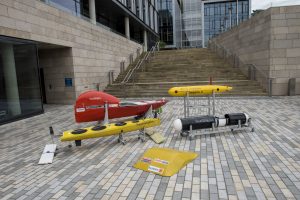
The MRL’s fleet of vehicles was on display as well as the excellent facilities within the Lab within easy access of B185 for trialling performance in the new towing tank.
Flapping with Fleur
MIT student Fiona Grant spent her summer internship in FSI working with Drs Nick Townsend and Gabe Weymouth working on the Maritime Robotics Lab vehicle Fleur. She uses wave energy to self propel herself into or with the waves. Fiona’s report below details some of her activities. We enjoyed her company and that of our five other interns and are grateful to our funding partners for their support and in particular the University’s EXCEL scheme.
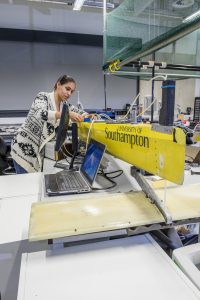
This summer I worked on a project studying the behavior of flapping foil systems. Flapping foils are devices modeled on the swimming mechanism for cetaceans and many fish. These devices have been widely researched, and it has been shown through experiments and simulation that flapping foils can be used to both harvest energy and produce thrust. The relationship between the magnitude and phase of the foil heave and pitch motions defines these two modes. Flapping foils have been successfully implemented in several full scale applications, including ships and wave energy converters (WECs). Currently, the optimal control and stability of flapping foil systems is being investigated, and more research is needed to solve this problem.
The system for this project was a model vessel with a pair of flapping foils attached at the stern. The goal for the summer was to gain an understanding of the dynamic behavior of the system and design a velocity controller for the vessel. I began by modeling the dynamics of the vessel and a single foil in calm water. I then worked on setting up the hardware, LabVIEW code, and driver software to control the linear motor that actuates the foil. In the final two weeks, we were able to run tests in the towing tank and collect data on the open loop response of the vessel and foil system for a range of frequencies and amplitudes.
This internship was a great experience. I was able to put my knowledge of control theory and experimentation techniques into practice and affirmed my desire to study control systems in graduate school. Throughout the internship I was able to work with computer simulation, hardware and software integration, and model testing. During my project I had guidance from my supervisors, but also a level of independence that allowed me to explore the topic and make my own choices about the research. I now feel more prepared for graduate school and excited about continuing my studies.

